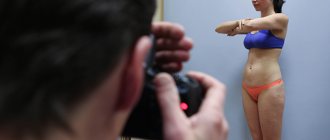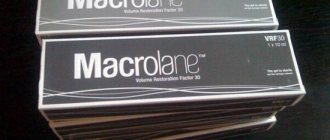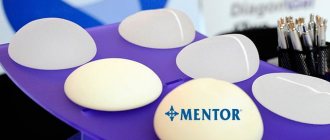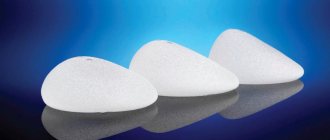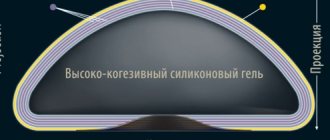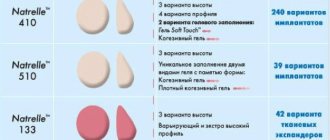Modern plastic surgery offers ample opportunities for correcting body contours. One of them is buttock augmentation surgery - gluteoplasty. It allows you to adjust their shape and size through the use of special implants. They are placed under the gluteal fascia or gluteus maximus muscle. Buttock augmentation with implants is available for both women and men. With the correct selection of implants, this plastic surgery allows you to achieve the desired effect. On our website you can see photos before and after buttock augmentation with implants.
Features of buttock augmentation with implants
Augmentation with implants is called endoprosthetics or gluteoplasty. The essence of the operation is that a small depression (the so-called pocket) is first made between the muscles in the patient’s sacral area.
This cavity serves as a place to place an implant (silicone or filled with saline).
There are 3 types of implant placement:
- under the fascia above the gluteus maximus muscle;
- between muscle fibers;
- under the muscle.
The surgeon will help you select the staging option. Under no circumstances should it be implanted directly under the skin, otherwise the transition boundaries will be noticeable, and the implant itself may shift and become deformed due to unreliable fixation.
The most commonly used installation is under the muscle.
Plastic surgeon Douglas Senderoff (New York)
There are two main types of artificial implants:
- anatomical, which have a natural teardrop shape;
- round.
In addition, buttock implants can be smooth or porous, and have different sizes and shapes. It is believed that smooth material is more durable, hygienic and does not tend to deform over time.
Silicone implants are more durable, and their structure is similar to the natural structure of human muscles.
There is no need to worry that buttock implants may not withstand physical activity or become deformed over time. The material for these products is extremely durable. It can easily withstand the effects of natural physical activity, sports, etc.
The structure of the implants is as follows:
- Strong dense shell.
- Filler (medical silicone or saline solution).
All butt implants come with a lifetime warranty and unlimited use.
The size, shape, and location in the soft tissues of the buttocks are selected strictly on an individual basis.
The process of selecting equipment, the future shape of the buttocks and materials occurs in personal agreement with the plastic surgeon, but based on the client’s personal recommendations and wishes.
The key factor in this is the anatomical features of the buttock structure and the state of human health. The operation is performed under general anesthesia to minimize pain and psychological discomfort for the patient.
You should not order implants that are too large if you have a lack of fat in your buttocks. This can lead to the boundaries of the transition being noticeable, and the body will look disproportionate and not aesthetically pleasing.
After the operation and rehabilitation period, the sutures are tightened quite quickly. However, it is not necessary to see a doctor to remove stitches.
| Problem | Method |
| Flat buttocks | |
| Flat top | |
| Flat outer sides | |
| Flat inner sides | |
| Flat bottom |
The period of complete rehabilitation is quite long and averages 5–6 months. There are other ways to enlarge the buttocks. They are presented below.
How to understand that the prosthesis is torn
Despite the high quality of products, it is impossible to completely exclude the presence of hidden defects in their shell. These defects can lead to gradual leakage of the filler or rupture of the silicone shell. If the filler is a saline solution, it will be absorbed from the surrounding tissue. In this case, the implant, gradually losing its salt filler, shrinks. If a prosthesis ruptures, the fluid is distributed very quickly into the tissues. All this, accordingly, gradually or very quickly leads to a decrease in the volume and deformation of the buttock.
In the event of an intracapsular rupture of an implant with a silicone filler, the gel does not migrate anywhere, but remains within the capsule formed around the implant. Such a gap goes unnoticed for a very long time, since the shape and volume of the buttock practically do not change for a long time. Some patients may experience mild to moderate pain. In these cases, magnetic resonance imaging or computed tomography helps to diagnose a rupture of the membrane with a high percentage of probability.
Extracapsular damage to the silicone-filled shell does not lead to significant spreading due to the high viscosity of the gel. The latter remains for a long time in nearby surrounding tissues, which in places of contact with it leads to a sluggish aseptic inflammatory process, which is manifested by unpleasant sensations and mild pain. The shape and volume of the buttocks, due to the pronounced load on them, may change after a certain time. Then granulomas form, which can sometimes be “palpated” in the form of nodes, and later capsular contracture may develop.
Result of buttock enlargement
Lipofilling (with your own fat)
In some cases, surgeons may use fat tissue removed from the patient himself. An important condition for this is the presence of fat accumulations on the body sufficient to give the desired shape and size.
This substance is extracted extremely delicately, so that a minimum number of cells are damaged.
Donor material is collected under completely sterile conditions, so the patient has nothing to worry about. In this case, fat cells are transplanted directly under the skin or fascia.
This type of buttock augmentation is called lipofilling. If all manipulations were carried out according to the rules, and the patient himself observed the restrictions during rehabilitation and followed all recommendations, then the possibility of resorption of adipose tissue is minimal.
It must be remembered that on average about 30-50% of fat will be absorbed after the intervention. This is impossible to predict, so the risk of asymmetry increases.
Plastic surgeon Lee Kleiman
Sometimes the plastic surgeon may additionally treat the donor tissue with plasma synthesized from the client's own blood.
The rehabilitation period for lipofilling lasts less, since the patient’s biological tissues take root better and faster.
An important condition is to wear special compression garments for approximately 30 days from the date of the operation. During this time, the fabrics will take on their final shape.
You can also combine the installation of implants and lipofilling to get the perfect result.
Plastic surgeon Ryan Stanton (Beverly Hills, California)
Using mesothreads
An alternative way to correct the shape and size of the buttocks is to enlarge them using special bio-threads. This special material is placed in a fan pattern under the gluteal muscle. This method allows you to significantly tighten the soft tissues and improve the shape of the buttocks.
There is no need to worry that bio-threads (meso-threads) may break or move - small hooks are used to securely fix them.
Thanks to this, the muscles and thighs are compressed, and the buttocks become more rounded and toned. At the same time, the rehabilitation period is the shortest of all the proposed types.
This method of tightening has a short-term effect - up to 2 years.
Location options
Gluteoplasty involves different placement of endoprostheses in tissues. It is selected in accordance with the individual characteristics of the patient and the purpose of the operation. It is important that buttock augmentation with implants results in the most natural appearance of this area. They are installed:
- under the gluteus maximus muscle,
- under the fascia,
- intramuscularly.
The choice of location for the endoprosthesis is also influenced by its own parameters.
Indications for gluteoplasty
How to determine that you need the help of a plastic surgeon to enlarge your buttocks and give them a seductive shape?
Below are a number of indications for the use of gluteoplasty.
INDICATIONS
- too small and inexpressive (or too large and disproportionate) buttocks;
- sagging soft tissues, loss of elasticity;
- the presence of post-operative marks and scars (in some cases);
- changes in the shape of the buttocks as a result of age, weight loss/gain;
- consequences of injuries;
- partial atrophy of fascial muscles.
Contraindications for surgery
Although buttock augmentation is not a particularly complex operation, there are still a number of direct and indirect contraindications that should be strictly adhered to.
CONTRAINDICATIONS
- acute diseases of internal organs;
- any chronic diseases of the internal system;
- any blood diseases, diabetes;
- dysfunction and disorders of the endocrine system;
- HIV AIDS;
- after insolation and ECG;
- if the patient has a tendency to form keloid scars;
- after following a strict long-term diet (the body may be exhausted);
- in the presence of severe diseases of the cardiovascular system.
There is no point in saving on your health, so you should only choose a clinic with a good reputation for performing the operation. Before you begin, you must have a face-to-face consultation with a surgeon, as well as undergo a number of preliminary tests and additional studies that he will prescribe for you:
- blood tests - general and biochemical;
- coagulogram;
- general urine analysis;
- tests for the presence of hepatitis viruses, HIV, syphilis;
- fluorography.
How to prepare for surgery?
Preparation for buttock enlargement should occur in stages. First of all, 2 weeks before the scheduled date of the operation, you should completely stop taking alcohol, as well as drugs that directly affect blood clotting.
The operation will be better tolerated on an empty stomach, so it is necessary to stop eating 6-8 hours before the implantation of implants in the buttocks.
The result after gluteoplasty can be predicted, which cannot be said about lipofilling, since part of the fat is absorbed.
Plastic surgeon Douglas Senderoff (New York)
A video with recommendations and features of endoprosthetics can be viewed below.
If on the eve of the operation the patient is very nervous or suffers from insomnia, then it is allowed to take sedatives and hypnotics.
The operation usually does not last long - from 1 to 3 hours. The rehabilitation period is quite long and ranges from 4 to 6 months, depending on the individual characteristics of the body.
At this time, swelling, redness, swelling, and numbness at the installation sites may be observed in the buttock area.
There is no need to panic, as these phenomena do not pose a threat to health or the condition of implants in the buttocks. Reviews about rehabilitation can be read on thematic forums on the Internet.
What kind of buttock implants are available?
In order to carry out the necessary correction, various companies offer buttock implants, which in their structure and composition are very similar to breast implants. They are a shell whose cavity is filled with a special gel or saline solution.
The strength and thickness of the shell of prostheses intended for gluteoplasty is significantly superior to those for mammoplasty.
Fillers
The advantage of saline-filled implants (bioimplants) is their relatively low cost. Otherwise, they are significantly inferior to silicone prostheses in almost all characteristics. Over time, they lose their volume, and therefore it is often necessary to replace them.
Another unpleasant feature of saline implants is the appearance of specific sounds while walking or other active movements.
In addition, the shell of saline-filled implants is less resistant to intense physical stress, as a result of which it can rupture. The saline solution easily flows out and is distributed in the tissues and, despite the fact that it is not dangerous, it nevertheless requires replacing the prosthesis. Due to these reasons and taking into account the high physical and mechanical loads on the buttocks, for the purpose of aesthetic correction, buttock implants made of eurosilicon are mainly used.
The shell material of all prostheses for gluteoplasty is a high-strength, highly elastic and resilient silicone elastomer with a thicker and denser barrier layer, unlike breast implants. Silicone elastomer, which is a durable multilayer (about 15 different layers) structure, makes it possible to provide the buttocks with high elasticity and hardness, characteristic of trained people.
The gel filler is a highly cognitive (viscous) gel with cross-biochemical bonds and has a fairly high degree of “memory effect”.
All these qualities of the gel provide the product and, accordingly, the buttocks with a natural external shape and naturalness to the manual touch.
In the manufacture of prostheses, manufacturers give the main advantage to a gel with a dense consistency due to the possibility of significant physical stress on the corresponding area. In addition, they are not subject to deformation and wrinkling.
Saline (transparent) and gel (matte) implants
Shape and texture
The shape of the rear surface of the endoprosthesis also contributes to achieving optimal results - it can be concave or straight. In addition, products are produced with the surface:
- smooth;
- textured;
- microtextured.
The use of buttock implants with a smooth surface is currently minimal due to their unstable “behavior” (mobility). The last two types of products are characterized by a higher degree of strength and better tissue germination compared to smooth ones (formation of a natural capsule), and therefore a significantly lower risk of displacement after installation.
Product from POLYTECH®
The shapes of buttock implants are also different:
- round, allowing you to increase the volume and roundness of the gluteal areas; however, the use of such implants does not allow the buttocks to change anatomical shapes during human movement;
- anatomical, or oval, also used to give the buttocks greater roundness and volume, but without the disadvantages of rounded implants;
- teardrop-shaped, designed to correct deformities formed as a result of damage to the gluteal areas.
POLYTECH® buttock implants
Dimensions
The size of butt implants is also very variable. Manufacturing companies, as in the case of breast prostheses, offer a wide range with a wide variety of parameters, which allows plastic surgeons to select the necessary products depending on the wishes of the patients and their individual characteristics. For example, oval dentures with a concave rear surface can have a volume of 115 ml with parameters of 80, 27, 120 mm, as well as a volume of 215 ml, 290 ml, 360 ml, 450 ml with other sizes, round - from 200 to 500 ml and etc.
Implants for correcting the shape and volume of the buttocks POLYTECH®
Thus, manufacturing companies produce various types of buttock implants with a wide variety of parameters, sterile and packaged individually.
Depending on the individual characteristics of the patient’s tissues and the shape of the buttocks, prostheses can be installed under the gluteus maximus muscle (preferably), less commonly, between the gluteus maximus and medius muscles, or subfascially.
You may be interested in other butt lift methods.
Question answer
You may be able to “feel” your butt implants when you sit for a while after surgery. But later, the implants are usually included in the image of your body, and after a while they are perceived as part of the buttocks. In other words, your brain considers them part of your body. The same thing happens with breast implants, which simply become a “part” of the body after a few months of implantation.
If done correctly, butt implants should not be noticeable. To ensure the success of your procedure, be sure to choose a board-certified plastic surgeon with extensive experience. Although even if the operation was performed by a professional, you can feel the implant. If you want to get a natural feeling, just pay attention to lipofilling (injection of fat). This procedure can give a natural feeling.
Buttock implants don't rupture because they are not like breast implants: they are completely solid and not filled with something.
Postoperative period (7 stages)
You should also follow some recommendations during the recovery period:
- It is better to spend the first 24 hours after surgery in a hospital, where qualified doctors can provide their patient with the necessary care.
- For the first 7 days you only need to lie down and not do any physical activity.
- It is necessary to limit the body's sitting position as much as possible.
- It is not recommended to visit a public swimming pool, sauna, or solarium for about a month and a half.
- You should not engage in physical activity for the first 30 days after surgery.
- It is necessary to limit or completely stop drinking alcoholic beverages and smoking.
- For about 3 months you must wear special compression garments.
Patients return to their previous lives after 2 weeks. Recovery after lipofilling takes longer (about 3-4 weeks).
Plastic surgeon Douglas Senderoff (New York)
If after surgery you feel painful symptoms, then, in consultation with your doctor, you can take painkillers that the doctor will prescribe.
Scars are hidden in natural folds. Over time they become less noticeable.
Plastic surgeon Stanley Okoro (Atlanta)
Recovery after surgery
The first few days of the recovery period will be difficult due to swelling and pain. A slight increase in temperature is also possible. Unpleasant sensations can be relieved with medications prescribed by a doctor. And to reduce swelling and speed up the implantation of endoprostheses, it is necessary to put on compression garments immediately after the operation and wear them for 4-8 weeks.
To read: How hardware body correction is carried out, methods of implementation
Buttock surgery with implants requires some restrictions during rehabilitation:
- You can’t lie on your back for up to 4 weeks, you can lie on your stomach and side,
- you still shouldn't go back to bad habits,
- it is forbidden to overheat (sauna, hot bath and solarium are prohibited) and overcool,
- Do not swim in open water or chlorinated water,
- I will have to give up sports for the next 3 months.
The conditions are simple, but mandatory. Ignoring them leads to the fact that buttock implants will have consequences that are not at all decorative for the figure. Seroma or hematoma may develop, asymmetry may occur, gait may be impaired, and increased or decreased sensitivity of this area may persist.
Buttock implants, consequences and complications
The most common problem that occurs after surgical buttock augmentation is rejection of the implant by the patient’s body.
In some cases, a negative reaction from the immune system may occur. In addition, there is a small percentage of complications occurring after the patient has undergone anesthesia:
- Wounds received during surgery can take a long time to heal, and if improperly or improperly cared for, they can even become infected. In this situation, repeated surgery will be required to remove the implants.
- In some cases, fibromas and keloid scars may form at the site of the sutures.
- Sometimes the patient may experience increased sensitivity of the buttocks, they may feel very cold or hurt. This is caused by damage to blood vessels and nerves. These symptoms may cause a person to have problems with their gait. Such cases require mandatory removal of the implants.
- In some cases, atrophy of the gluteal muscles may begin.
The sensations after surgery are similar to severe muscle pain after a long workout. There may be a burning sensation.
Plastic surgeon Stanley Okoro (Atlanta)
A 2013 study published in the Journal of Plastic and Reconstructive Surgery found that of 2,226 patients who underwent buttock implants, 38% experienced some kind of complication, but by 2021 this number had dropped significantly to 21.6% (that's attributed to the fact that the experience of doctors has increased).
Most often, patients encountered suture dehiscence during rehabilitation. People also experienced infection, seroma (fluid accumulation) and soreness that lasted longer than the typical two-week recovery period. There is also a small risk of the implant becoming dislodged, often resulting in pain and fever.
About 5% of patients in the 2021 study required implant revision, and implant removal was performed in 3.8% of cases due to infection, pain or seroma. This is higher than usual for cosmetic surgery, but if you are choosing between butt implants and a Brazilian butt lift, keep in mind that the risks associated with implants are much less severe.
Serious complications may be associated with inexperienced surgeons or poor technique.
Prices for operations
The implantation of implants in the buttocks is considered an expensive procedure; the price will start from about 100 thousand rubles, depending on the type of augmentation and the individual policy of the clinic.
In addition, it is worth considering that you will additionally have to pay for anesthesia, hospital stay and the provision of compression garments.
The most inexpensive operation is considered to be trimming fat deposits. More expensive is lipofilling – correction of the shape of the buttocks with the patient’s own fat.
For an increase in bio-threads you will have to pay about 2 times more.
The most expensive operation is the one involving buttock implants. The price in Moscow will start from approximately 120 thousand rubles. However, this is the only method that has lifetime effectiveness and a guarantee.
The rehabilitation process should include approximately 10 sessions with a doctor, which will also have to be paid additionally.
How is the procedure performed?
The intervention begins with giving the patient anesthesia. Anesthesia is usually general, as the operation lasts up to 2 hours. The surgeon then cuts the skin in the area between the buttocks. The incisions are no larger than 5 cm. This access makes the seams invisible. Silicone buttock implants are placed in specially formed cavities. First, manipulations are performed on one side, then on the other. Finally, the doctor places sutures made of absorbable or completely synthetic material. If the implant is large, drainage tubes are installed.
Expert opinion
- Cosmetologist
- Surgeon
Irina Dorofeeva
practicing cosmetologist
During recovery from buttock augmentation with implants, you are not allowed to sit for one week after surgery. Patients can stand, lie on their stomach or side. After a week they can sit for ten minutes every hour. Scars that are located inside the buttock crease are easily hidden by swimsuits and most types of underwear.
Michelle Place
plastic surgeon
Like any surgical procedure, recovery occurs in stages.
Definitely the first two weeks are the hardest. Walking is acceptable starting the very next day, but it will take 2-3 weeks until it becomes habitual. Thus, most patients will need to spend at least two weeks away from work, and some may need 3-4 weeks. If you are unable to correct the shape of your buttocks through fitness classes or simply by gaining weight, then we advise you to think about gluteoplasty.
This surgical operation is almost guaranteed to help achieve the desired effect and quickly get the figure of your dreams. Moreover, some types of these operations will be effective throughout life.
Watch a video on this topic, read reviews, look at the “before” and “after” photos of implanting implants in the buttocks and, if you decide, then confidently go towards your dream of a beautiful body.
Types of implants
The result of plastic surgery depends largely on the type of endoprosthesis. They are made from durable materials that can withstand the weight of a person, and filled with silicone. According to their shape, implants are divided into:
- Anatomical, which give the buttocks the most natural look. But they can significantly change the shape of this part of the body, and not just increase volume.
To read: Cryolipolysis procedure: effect before and after, indications and contraindications
- Round, allowing you to significantly enlarge the buttocks. Their use is preferable when there is really a need for it. Otherwise, the buttocks will look “pumped.”
According to the surface texture, implants can be smooth or rough. The former are considered more suitable for gluteoplasty; they cause fewer complications. But rough ones are held more firmly in tissues.


